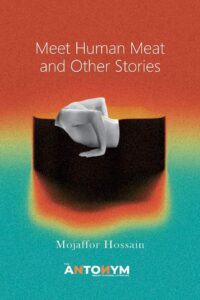A BOOK REVIEW OF MOJAFFOR HOSSAIN’S COLLECTION “MEET HUMAN MEAT AND OTHER STORIES” BY PINA PICCOLO
Mojaffor Hossain’s latest short-story collection, translated into English from Bangla by a team of 8 stellar translators and published by The Antonym (Kolkata, 2023), cunningly combines in its title “Meet Human Meat and Other Stories”, the early 21st century formulaic exhortation “Meet” with the darkly grotesque suggestion of ‘civilized’ cannibalism consumed in trendy restaurants. Taken from one of the 17 stories that make up the book and is strategically placed at its center, this assonant title with its disquieting echoes introduces the reader to a whole universe of contemporary contradictions. Some belonging to mundane, everyday experiences located between Bangladesh and India or the troublesome border between the two and some set in a surrealistic territory of the imagination, uncomfortably close to reality. As a matter of fact, the book’s opening story revolves around a procession of the spirits of differently mutilated people, trying to return to a village from which they had fled ahead of an invasion and ends with a story centering on a macabre football match that is the object of desire of a group of destitute teenage boys, kicking their frustration and lack of future around.
One of the salient features of Mojaffor Hossain’s dense yet airy writing is the variety of storytelling devices the writer effectively wields to keep the reader engaged as they are shifted between locations and characters, points of views and paradoxical situations. The writer relies chiefly on the dynamism of the narrating voice to creatively unfold layers of history, prejudice, deceit, domination, scapegoating as well as the demand for justice and a saner way of life; claims that strike the reader either implicitly as for example in “All the Sadeqs Are Getting Killed” or explicitly, as occurs in “The Story I Could Never Write”.
The storytelling is entrusted sometimes to an individual narrator — whether omniscient, slightly naïve or unreliable, “My Mother Was a Prostitute”, “Post Breaking News”, sometimes to two dialoguing /contrasting voices, “Down Memory Lane”, “An Ad Seeking the Identity of a Hand”, “A River Story”, sometimes a polyphonic chorus or cacophony, “Subservient Country, Independent People”, “The Spy”, “Land of the Headless”, sometimes to a mix of the above “A Farewell Verse”, “The Story I Could Never Write”. Thus a multitude of narrators accompany the reader through the circles of a contemporary hell with its catalogue of raped and burnt women appearing on the edge of the bed to sleepless writers, demanding that their story be told; village life with its traditionally appointed bullies and scapegoats coming apart at the seams as technology, bureaucracy and vagaries of modern life seep in; the ongoing religious acrimony between Muslims and Hindus and the paradoxical situations and intrigues it gives rise to, and their long standing consequences; the power of the media and hearsay to set up Pirandellian situations in which a living body itself does not suffice to prove one’s alive status.
In spite of the jarring, speculative and oftentimes ominous fabric of the stories, Mojaffor Hossain manages to elicit in the reader, an underlying sympathy for the characters who are situated on lower rungs of the ladder of abuse— I am thinking of the son in “My Mother Was a Prostitute,” or the inept village poet with a grifter’s angle in “A Farewell Verse”. Though they partake in abuse and scapegoating, by their actions they demonstrate a kind of loyalty to the victim—again the son of the prostitute by choosing to live next to the mother buried in the courtyard of her own home as she is refused proper burial by the village norms against prostitutes.
The character of the inept poet, failing in the task that the village expects him to perform, that is, to versify and the scorn that failure brought on him, reminded me of the notion of concentric circles of stories that I see, played out in this book. Salman Rushdie mentioned the importance of this kind of storytelling in his remarks about how Covid had affected this activity in a 2021 interview reprinted in Lit Hub:
Stories are the things that tell us who we are. And for me, that’s the great value of doing this kind of work. We are a narrative animal. We’re an animal that understands itself by telling stories. Children want stories very early as a way of understanding the world. And all of us, we live in stories. Families have family stories. Cities have stories of the city. Communities, secular or religious, have stories which define them. Countries have national stories. And we live in these concentric circles of stories, and we understand ourselves through them. Stories contain, in the most beautiful way, what we have been, the potential of what we could be, speculations about how we might be. They are the memory of the human race. And it’s one of the beautiful things about being in that world, trying to make stories which become—if I’m lucky—part of that collective memory.
In the concentric stories that Mojaffor Hossain offers in this collection, I detect something Italo Calvino had been advocating in his book, Six Memos for the Millennium under the rubric ‘Lightness’. Here, the lightness is not due to lack of substance. Readers are invited to follow an intriguing red balloon, buoyed in the air by the contradictions of society. In a polyphonic display of clashing and colluding modernity and tradition, relations between classes, sexes, generations, religions, city and countryside, professions, new and old while managing, in a way, to defeat the heaviness and darkness he could have gathered from the dire predicaments, the characters are facing. But talking of red balloons and their buoyancy should not deter readers from considering Mojaffor Hossain’s ability in bringing the reader closer to earth, to the actual mud and dust of life. In describing the macabre game of soccer, played by the destitute boys, in all its elements and surrounding contexts of family, neighborhood, national and international life, the author deploys all his skill in saying and not saying, barely hinting at the nature of what’s inside the rags that constitute the football, thus fitting to a renowned scholar, Wolfgang Kayser’s remarks about the grotesque as a genre in its modern day form:
In literature the grotesque appears in a scene or animated tableau. Its representations in the plastic arts, too, do not refer to a state of repose but to an action, a “pregnant moment”, or at least — in the case of Kafka — a situation that is filled with ominous tension. In this way the grotesque the kind of strangeness we have in mind is somewhat more closely defined. We are strongly affected and terrified because it is our world which ceases to be reliable, and we feel that we would be unable to live in this changed world. The grotesque instills fear of life rather than death. Structurally, it presupposes that the categories which apply to our world view become inapplicable.” The various forms of the grotesque are the most obvious and pronounced contradictions of any kind of rationalism and any systematic use of thought. (Wolfgang Kayser, The Grotesque in Art and Literature, page 185).
amazon link: https://www.goodreads.com/book/show/127567695-meet-human-meat
Also read, The Oracle Has Spoken by Kokouvi Dzifa Galley Translated from The French by Dodzi Edem Amenyo and published in The Antonym:
Follow The Antonym’s Facebook page and Instagram account for more content and exciting updates.



























0 Comments